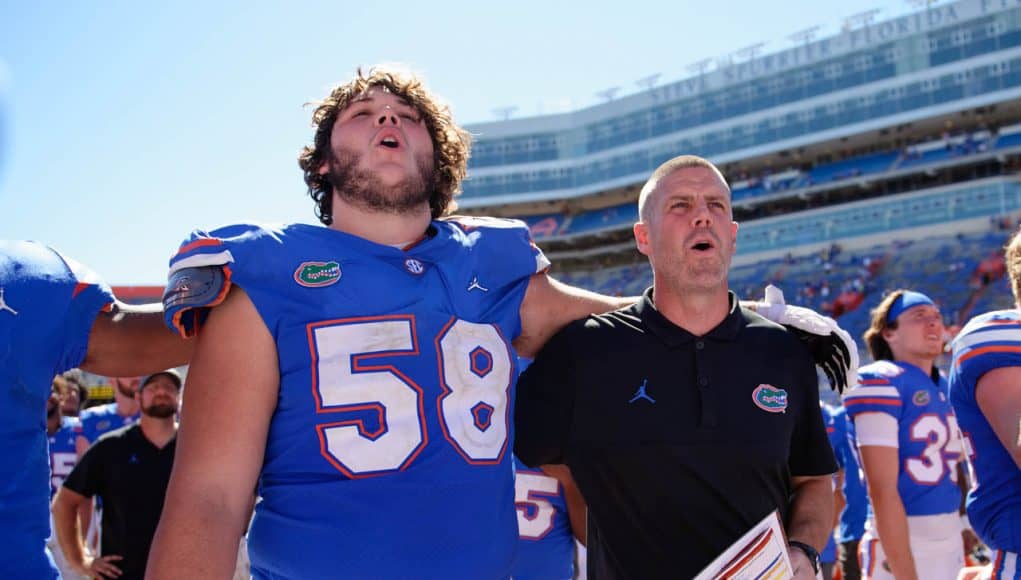Last week, I told you that the biggest key to Florida’s game against UCF was the defensive line playing at a new, higher level that it hadn’t yet proven it could do. Fortunately for the Gators, the line did have its best game yet against an FBS opponent as UF rode its defense to a 24-13 win.
This week, the spotlight needs to be on the other side of the trenches. The Florida offensive line is facing a very tough test in the Tennessee defensive front, and how the line performs is going to go a long way to determining the outcome of the contest.
To begin with, health is an issue. On the Wednesday night availability report, starting left tackle Austin Barber was listed as questionable, and backup left tackle Devon Manuel was deemed out.
There is no word on who the left tackle might be if Barber can’t go because Billy Napier isn’t releasing depth charts anymore, but on some level it doesn’t really matter. The gap between Barber and the third choice at the spot is enormous. It will be very hard to envision a good outcome if Barber can’t go. I’m writing the rest of this as though Barber will play, but adjust expectations downward should he not dress.
Pass rush initially looks like it might not be as big an issue as you’d think. Florida has cut its overall sack rate more than in half since a year ago despite playing some tough defensive fronts in Miami and Texas A&M. Last year against FBS competition, UF allowed 39 sacks in 406 drop backs — meaning pass attempts plus sacks. That comes out to a rate of 9.6%. It’s hard to have a great offense when one in ten drop backs results in a sack.
So far this year against FBS opponents, UF has allowed just five sacks in 116 drop backs. The rate comes out to 4.3%, which is much improved.
Tennessee, despite having one of the most highly regarded defensive fronts in the country this year, is not sacking opposing quarterbacks at a superlative rate either. The Vols have eight sacks against FBS opponents in 110 drop backs, which comes out to a rate of 7.3%. Florida’s own defense, which is not exactly feared in many backfields, has nine sacks in 118 drop backs for a 7.6% rate against FBS foes.
That said, all of Florida’s sacks allowed came against the Hurricanes and Aggies. UF had a talent edge over Mississippi State and UCF, and it used that edge to keep its quarterbacks clean. When the defense had the advantage, the Gators allowed five sacks in 60 drop backs for an 8.3% rate. It’s only a marginal improvement over a year ago — one sack for every 12 drop backs, instead of one for every 10.5 drop backs — and unacceptably high.
It’s important to keep the passer upright because if there is any headway to be made against the Vols’ defense, it’s through the air. In their upset win last weekend, Arkansas only rushed for 3.4 yards per carry (sacks removed) but completed 70% of its passes for 9.9 yards per attempt.
Tennessee’s rushing defense leads the SEC in sack-adjusted yards per carry allowed against FBS opponents at a mere 2.42. UT hasn’t faced a murder’s row of rushing attacks yet, but even so, that’s an impressive number.
The Gators did a poor job of moving the ball on the ground against Miami and Texas A&M. The Aggies are actually 14th in the conference in the same measure with 4.64 sack-adjusted yards per rush allowed, but Florida managed just 3.2 yards per carry for the lowest mark TAMU has yet allowed on the season.
UF’s overall rushing stats against Miami look nice, but they’re heavily skewed by Montrell Johnson’s 71-yard touchdown run. Take that out, and the Gators ran for a sack-adjusted 3.58 YPC on their 24 other attempts against the Hurricanes.
The offensive line will need to do something we haven’t yet seen from them to allow the Gators’ rushing game to do much of anything other than keep the clock moving in between plays. It could happen; the defensive line played its best game yet after I spotlighted them last week. However, it’s true that it will take something unprecedented to get there.
Believe it or not, Florida might just provide the toughest test to the Tennessee defense yet. Two of the Vols’ opponents have been FCS Chattanooga and Kent State, the latter being a serious contender for worst FBS program in the country. Their non-cupcake games have been against a mediocre NC State team out of conference plus Oklahoma and Arkansas. OU’s leading rusher is under four yards a carry for the year, while its top two pass targets are both under nine yards per catch. Arkansas’s starting quarterback has a passing efficiency of 120 against FBS teams, compared to the 148 of the combined efforts of Graham Mertz and DJ Lagway.
With Tre Wilson and Aidan Mizell back available this week, UF’s skill positions will be as stocked as they’ve been all year. The path to pulling off the upset on the road requires a run game that does just enough to keep the passing defense honest to allow the quarterbacks and receivers to win the game.
The offensive line has a key role in both of those propositions: give the quarterbacks enough time to throw, and hold the defensive front back just enough to keep every other run from getting stuffed at or behind the line of scrimmage. Florida’s chances in the game go as far as the offensive line will take them.


